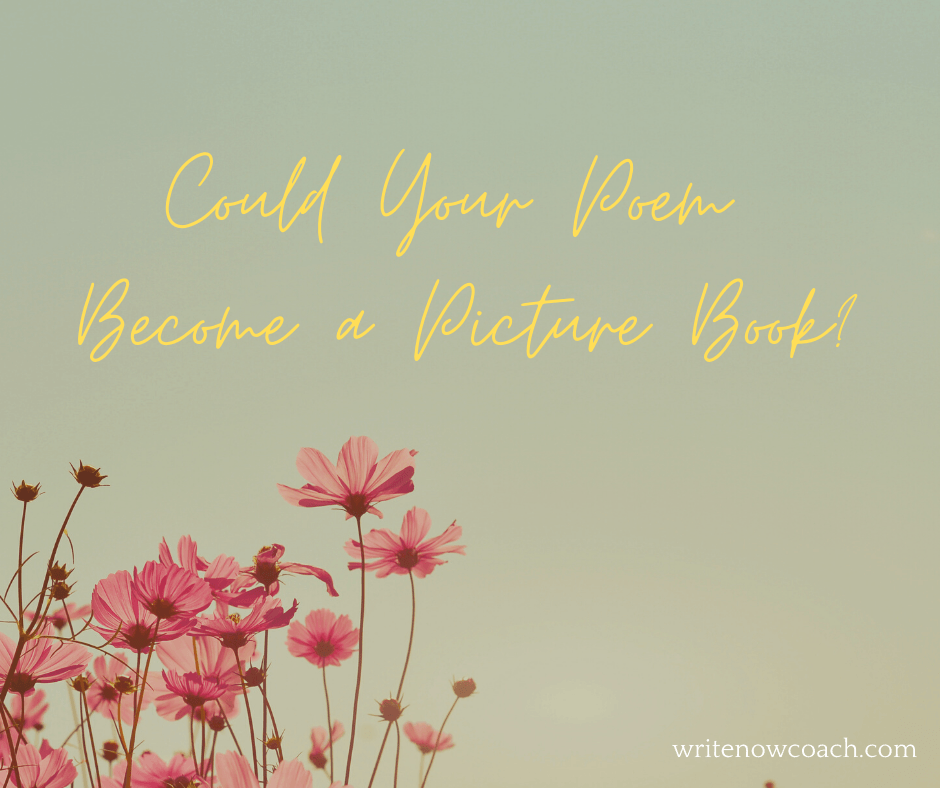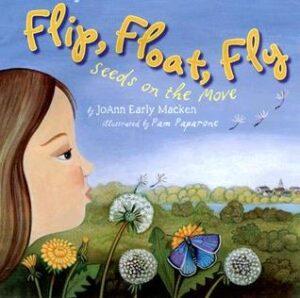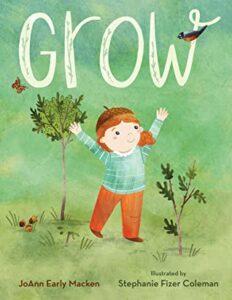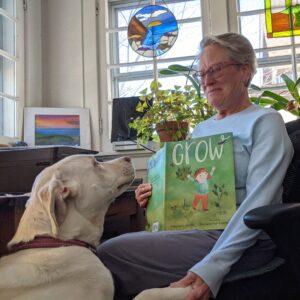Could Your Poem Become a Picture Book?
April 27, 2021
Note From Rochelle
Dear Writers,
Have you checked out my new website and blog yet? If you write for children (or teach or manage a library), Tales for the Mighty Writers might appeal to you.
If you struggle with social media–what do I post about????—you might find help with my post on building a social media plan over on Fiction University.
Today, I’m delighted to welcome JoAnn Early Macken to the blog to talk about how writing poetry can lead to writing picture books. JoAnn has a brand new picture book out, Grow.
Enjoy!
Rochelle

Could Your Poem Become a Picture Book?
By JoAnn Early Macken
Happy National Poetry Month! Although April is coming to a close, I’ve been piling up a trove of resources to keep playing around with. This year, as I’ve done in the past, I’m writing a poem every day for the month. I find that writing one short poem a day is a manageable goal, and the process can act as a warmup for further writing.
Spring inspires me, so I always find plenty of ideas—enough, in fact, that I keep a running list. It even includes a few ideas left over from previous years. I find that some topics I really care about keep popping up. Revisiting some subjects makes me approach them from different perspectives—one way of giving a project more potential.
As in previous years, I’m writing mostly haiku. The brief, concentrated form forces me to be concise, to get to the heart of the matter, and to make every word count—as picture books do. The leap from poetry to picture book can be a natural one.
Four of my picture books include rhyming stanzas, but you don’t need rhyme to make a poem or a picture book work. Other poetic techniques can enliven the text. My other two picture books both began as free verse.
 Flip, Float, Fly: Seeds on the Move (nonfiction from Holiday House, illustrated by Pam Paparone) explains how seeds get around.
Flip, Float, Fly: Seeds on the Move (nonfiction from Holiday House, illustrated by Pam Paparone) explains how seeds get around.
My new picture book Grow (Boyds Mills & Kane, illustrated by Stephanie Fizer Coleman) describes how different creatures develop. Both books use imagery to help clarify the text.
describes how different creatures develop. Both books use imagery to help clarify the text.
Play with Imagery
Most of us think in pictures, and imagery puts those pictures into words, often by making a comparison to a familiar object or process. In Flip, Float, Fly, a wild oat seed “curls up in the sun like a comma” and tumbleweed plants “grow round as globes.” In Grow, “Slowly, you’d crack your jacket” describes how an acorn sprouts in the ground. “You’d button yourself to a leaf” explains a step in a caterpillar’s transition to a chrysalis.
To help a reader understand what you mean, make a list of similes, metaphors, symbols, personification, and other types of imagery that fit your subject. Rather than use a comparison you’ve heard before, such as “white as snow” or “blue like the sky,” take time to think of a new way to describe your subject. Brainstorm using all of your senses. The most surprising comparisons can be the most interesting.
When you’ve written every image you can think of, take a look at your list. Do the images work together? Do they reinforce each other? Could they work as lines of a single poem? If not, don’t feel that you have to use them all. Combine your best lines to create a new poem or enliven an existing one. Save the others to use in another poem or story.
Listen for the Rhythm
Rhythm is an important component of poetry as well as many picture books, which are meant to be read aloud. Listen for regular patterns of sound when you read your work aloud—or have someone read it to you. The rhythm of a poem should match its feeling or mood: slow and smooth for a serious subject, bouncy and quick for a fun one, jarring if it suits the topic. Keeping a poem in my head on my daily walks helps me work on rhythm.
Use Exciting Language!
Exciting language is important for both poetry and picture books. Use active words, especially verbs. Specific words add interest and help clarify. (What’s the word for a scale on a turtle’s shell? I had to find out for Grow.)
The title Flip, Float, Fly: Seeds on the Move includes an example of alliteration, the repetition of the sound at the beginning of several words in a series. Another example from the same book is “Splash! Swish! Splatter! Scatter!” “Later, lankier, you’d sprint and then spring” is alliteration from Grow.
But wait…there’s more!
You can find out more about using these and other elements of poetry in my book Write a Poem Step by Step (Earlybird Press). You can learn more about writing picture books through the many wonderful programs offered by the Society of Children’s Book Writers and Illustrators (SCBWI). Here are some more suggestions:
- Read, read, read—not only published poetry and picture books but also weekly online posts shared in the Poetry Friday community.
- Try new poetry forms. The challenge could lead to surprising discoveries.
- If you get stuck, put the work away for a while and work on something else. (The poem that became Grow developed over many years.)
What a Poem Can Be
Poems can be jumping-off points, either to expand into longer works or to combine with other poems. If you generate a number of poems connected by a topic or theme, you could combine them into a poetry collection. You might address one concept in different forms or similar topics with one underlying theme. Depending on the age of your target audience, you might consider a novel in verse.
National Poetry Month is a wonderful opportunity to celebrate with poets across the country. But don’t forget about poetry when April ends! Keep reading and writing all year.
 About the author. JoAnn Early Macken is the author of six picture books, including Grow and Flip, Float, Fly: Seeds on the Move. Her poetry manual Write a Poem Step by Step is based on the workshops she has presented to students of all ages. She has also written more than 130 nonfiction books for educational publishers. A graduate of the M.F.A. in Writing for Children and Young Adults program at Vermont College of Fine Arts, JoAnn posts poetry on her blog at joannmacken.com.
About the author. JoAnn Early Macken is the author of six picture books, including Grow and Flip, Float, Fly: Seeds on the Move. Her poetry manual Write a Poem Step by Step is based on the workshops she has presented to students of all ages. She has also written more than 130 nonfiction books for educational publishers. A graduate of the M.F.A. in Writing for Children and Young Adults program at Vermont College of Fine Arts, JoAnn posts poetry on her blog at joannmacken.com.









THank you< JoAnn and Rochelle, for this helpful and interesting post.
I think May, June, and July might need to be poetry months for me. Thank you for your beautiful books.
Thank you JoAnn and Rochelle. JoAnn this is a Wonderful explanation of using poetry to prime the pump for longer work, as well as enjoying poetry in the shorter form.
Thanks for sharing these insights and writing tips! I used JoAnn’s book “Flip, Float, Fly” on my blog as a part of my fall phenology posts. Love her work.
https://www.laureannawrites.com/phenology-phorum/fall-seeds-spring-flowers